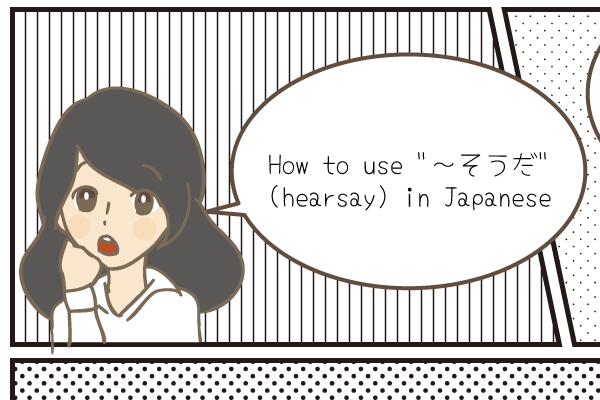How to use “~そうだ” (hearsay) in Japanese
Last week Shiho explained how to use “~らしい” to convey assumptions, hearsay and specific types of situational patterns. This time, we will take a look at the expression “~そうだ”, which we covered before. However, this time you will learn how to use “~そうだ” to express rumours and hearsay.
| Table of Contents [Short reflection] [About “~そうだ” (hearsay)] [Conveying information more neutrally] [The difference between “~そうだ” (describing things) & “~そうだ” (hearsay)] |
[Short reflection]
Up until this point, we studied three expressions that are very similar to each other: “~そうだ” (describing situations), “~ようだ/~みたいだ”, and “~らしい”. They all express very similar things, so it’s easy to mix them up. If you are confused after this article, we recommend re-reading the previous three articles to deepen your understanding of the differences between all of these expressions.
[About “~そうだ” (hearsay)]
Using “~そうだ” to convey “伝聞” (でんぶん) or rumour/hearsay means that the speaker is conveying information they have acquired through a source, meaning the speaker may have heard or read the information they are relaying somewhere.
Using “~そうだ” (hearsay) means that the speaker feels a sense of urgeny to relay what they’ve picked up somewhere, and that they feel their information is valuable. Therefore, “~そうだ” (hearsay) is not a neutral expression but includes the speakers emotions.
For example the speaker could say:
昨日九州で地震があったそうです。
I heard there was an earthquake in Kyushu yesterday.
This sentence does not only convey the fact that there was an earthquake in Kyushu, but includes the underlying information that the speaker thinks of this as important information and wants to convey it quickly.
[Including the source of information]
Furthermore, since “~そうだ” (hearsay) is used to convey informatiom acquired via a source, that source is often mentioned in the same sentence.
For example:
新聞によると、昨日九州で地震があったそうです。
According to the newspaper there was an earthquake in Kyushu yesterday.
In this sentence, the newspaper is the source of information. The speaker knew about the incident through the newspaper and is now relaying this knowledge to someone else.
[adsense]
[Conveying information more neutrally]
We have established that “~そうだ” (hearsay) includes the speakers emotions; that they feel to a certain degree what they have to relay is valuable information and needs to be heard quickly.
Now, what should you do if you simply want to relay information without this emotional undertone? If you are frequently listening to the radio or watching TV in Japanese, you may have heard this expression before.
The correct answer is: “~ということ”.
For example, the news could say …
九州の地震では、15名の死者が出たということです。
15 reported dead during an earthquake in Kyushu.
… since the news cannot say “九州の地震では、15名の死者が出たそうです”, as it would undermine the news attempt at neutrality and since the feelings of the news anchor aren’t needed in this scenario.
[Relaying a third party’s thoughts, feelings, & actions]
Another way to use “~そうだ” is to express a third party’s thoughts, feelings, or actions when placing it at the end of a sentence. For example:
小林さんは難しい試験に合格して嬉しいそうです。
Ms. Kobayashi seems happy about passing that difficult test.
However, when conveying a third party’s thoughts, feelings, or actions, your sentence cannot be in the past or interrogative form.
[How to use “~そうだ” (hearsay) grammatically correct]
Let’s take a look how to conjugate and decline the verbs and nouns to use with “~そうだ” (hearsay) correctly. While for the other form of “~そうだ” you were using the word stem + “~そうだ”, when conveying hearsay (or another person’s thoughts, feelings, and emotions) you use the normal form, or 普通形, of the verb or adjective and the normal form/普通形 + だ for nouns.
Let’s look at some examples!
Verb: 行く (to go)
行くそうだ/行かないそうだ/行ったそうだ/行かなかったそうだ
i-Adjective: 痛い (hurtful, painful)
痛いそうだ/痛くないそうだ/痛かったそうだ/痛くなかったそうだ
na-Adjective: 元気 (happy, in good spirits)
元気そうだ/元気じゃないそうだ・元気ではないそうだ/元気だったそうだ/元気じゃなかったそうだ・元気ではなかったそうだ
Noun: 休み (holiday)
休みだそうだ/休みじゃないそうだ・休みではないそうだ/休みだったそうだ/休みじゃなかったそうだ・休みではなかったそうだ
[The difference between “~そうだ” (describing things) & “~そうだ” (hearsay)]
Apart from the grammatical difference let’s take a look at the difference in meaning between the “~そうだ” that describes things and situations and the “~そうだ” that conveys hearsay and rumours.
Do you remember how to use the descriptive “~そうだ”? It has two meanings or ways you can use it.
The first one is expressing an expectation. The speaker is looking at a situation and concludes what is most likely to happen or how they judge a situation to be – for example judging a person might not come after they have made you wait for an hour, or looking at food and concluding it looks delicious – the speaker does not have proof for their expectations, but this is what they judge a thing or situation to be like.
The second one is expressing the possibility that something might happen. In other words, either way this type of “~そうだ” means the speaker has a situation at hand, judges it, and expresses their impression of said situation.
The “~そうだ” we studied today is used to convey or relay information you have acquired via a source – something you’ve heard someone say, something you’ve read somewhere, etc.
Let’s take a look at some example sentences and try to determine which type of “~そうだ” they are!
1) あのケーキは美味しそうだ!
2) このレストランは安くて美味しいそうです。
The correct answer is that sentence number 1 is the descriptive “~そうだ”: “This cake looks delicious” is the speaker’s expectation. Sentence number 2 is the rumour/hearsay “~そうだ”: “I heard this restaurant was cheap and delicious” is obviously knowledge the speaker has acquired via a source.
You can also determine the difference grammatically. For the descriptive “~そうだ” you use the word stem + そうだ (hence 美味しそうだ), while for the rumour/hearsay one, you use the normal form/普通形 of the word (hence 美味しいそうだ).
As you can see, the differences are very tiny but they are there! Just by including or leaving out the “い” in “美味しい” the meaning of the whole sentence changes! Make sure to try and use these expressions a lot when speaking Japanese and you’ll learn to differentiate between them more naturally. Good luck studying!
If you ever want to practice this expression with one of our native Japanese tutors, don’t hesitate to sign up on Wasabi and start with a trial lesson before deciding for anything!
| 伝聞 | Hearsay, rumor |
| 価値 | Worth, value |
| 情報 | Information |
| 含まれる | To be included |
| 表現 | Expression |
| 九州 | Kyushu (one of the four main islands of Japan) |
| 地震 | Earthquake |
| 重要 | Important |
| 情報源 |
Source of information |
| 報道 |
Information, report |
| 過去形 |
Past form |
| 疑問文 |
Interrogative sentence |
| 兆候 |
Sign, indication |
| 印象 |
Impression |
| 整理 |
Sorting, arrangement |




